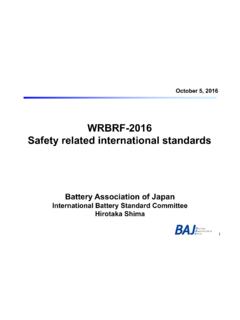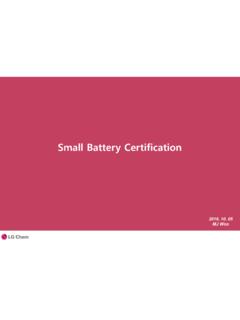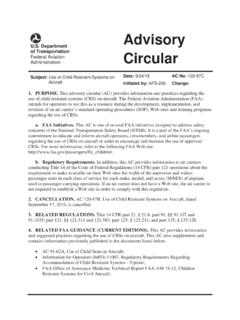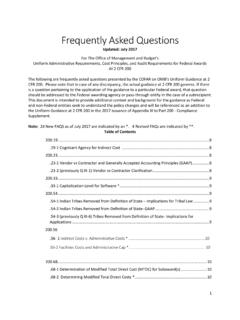Transcription of Lithium-Ion Batteries Hazard and Use Assessment
1 Lithium-Ion Batteries Hazard and Use Assessment final report Prepared by: Celina Mikolajczak, PE Michael Kahn, PhD Kevin White, PhD Richard Thomas Long, PE Exponent Failure Analysis Associates, Inc. July 2011 Fire Protection Research Foundation FOREWORD lithium ion Batteries are in widespread use in consumer electronics. As electric vehicles enter the marketplace, there is an expectation of a step increase in the number and size of battery packs in storage and use. The Foundation s Property Insurance Research Group initiated a study of the hazards associated with lithium ion battery storage, with an aim of developing fire protection strategies to mitigate loss associated with fire incidence with these Batteries in bulk storage and distribution, alone and in manufactured products.
2 The overall aim is to develop the technical basis for requirements in NFPA and other standards which prescribe protection requirements. The first phase of the project, described in this report , is a literature review of battery technology, failure modes and events, usage, codes and standards, and a Hazard Assessment during the life cycle of storage and distribution. It lays out a research approach toward evaluating appropriate facility fire protection strategies. The content, opinions and conclusions contained in this report are solely those of the authors. Lithium-Ion Batteries Hazard and Use Assessment Project Technical Panel Robert Galyen, Magna E-car Nicholas Marchica, Marchica & Deppa, LLC Guy Marlair, INERIS Michael O Brian, Brighton Area Fire Authority Ryan Posten, PHMSA, US Department of Transportation Carl Rivkin, National Renewable Energy Laboratory Mont Smith, Air Transport Association Mahmood Tabaddor, Underwriters Laboratories Inc.
3 Kaoru Wakatsuki, National Research Institute of Fire and Disaster Jiann Yang, National Institute of Standards and Technology Robert Zalosh, Firexplo Property Insurance Research Group Sponsors CNA Insurance FM Global Liberty Mutual Tokio Marine Management, Inc. Torus Insurance Travelers Insurance XL Group Zurich NA Project Contractor Celina Mikolajczak Failure Analysis Associates Lithium-Ion Batteries Hazard and Use Assessment Doc. no. A0F0 0711 CM01 Lithium-Ion Batteries Hazard and Use Assessment Prepared for Fire Protection Research Foundation 1 Batterymarch Park Quincy, MA 02169-7471 Prepared by Celina Mikolajczak, PE Michael Kahn, PhD Kevin White, PhD Richard Thomas Long, PE Exponent Failure Analysis Associates, Inc.
4 149 Commonwealth Drive Menlo Park, CA 94025 July 2011 A0F0 0711 CM01 ii Contents Page List of Figures v List of Tables viii Acronyms and Abbreviations ix Introduction 1 Chapter 1: Introduction to Lithium-Ion Cells and Batteries 3 Negative Electrode (Anode) 11 Positive Electrode (Cathode) 12 Electrolyte 12 Separator 16 Current Collectors 18 Cell Enclosures (Cases and Pouches) 20 Charge Interrupt Devices 24 Positive Temperature Coefficient Switches 25 Battery Pack Protection Electronics 26 Battery Pack Enclosures 27 Chapter 2: Lithium-Ion Technology Applications 29 Chapter 3: Summary of Applicable Codes and Standards 34 Hazardous Material Transportation Codes 34 Consumer Electronics Standards 37 UL Standards 37 IEC Standards 39 IEEE Standards 41 Automotive Application Standards 42 Fire Protection Standards 45 A0F0 0711 CM01 iii Chapter 4: Lithium-Ion Battery Failures 46 Cell and Battery Failure Modes 47 Non-Energetic Failures 47 Energetic Failures.
5 Thermal Runaway 48 Root Causes of Energetic Cell and Battery Failures 55 Thermal Abuse 56 Mechanical Abuse 57 Electrical Abuse 60 Poor Cell Electrochemical Design 63 Internal Cell Fault Related to Manufacturing Defects 63 Factors that Influence the Effect of Failure 69 Cell Chemistry 69 State of Charge 70 Heat Transfer Environment 71 Chapter 5: Life Cycles of Lithium-Ion Cells 72 Transport Practices 75 Transport Volumes 76 Transport Safety 77 Storage Facility Safety 78 Recycling 81 Chapter 6: Lithium-Ion Fire Hazard Assessment 84 Flammable Cell Components 84 Stored Energy (Chemical and Electrical) 88 Fire Behavior of Cells and Battery Packs 91 Fire Behavior of Battery Packs Packed With or Contained in Equipment 96 Effectiveness of Suppressants 97 Chapter 7: Lithium-Ion Fire Hazard Gap Analysis 102 Leaked Electrolyte and Vent Gas Composition: Gap 1 102 Lithium-Ion Cell and Battery Commodity Specification: Gap 2 103 Suppressant Selection: Gap 3 109 Incident Cleanup.
6 Gap 4 110 A0F0 0711 CM01 iv Acknowledgements 111 Limitations 112 A0F0 0711 CM01 v List of Figures Page Figure 1. A selection of typical consumer electronics Lithium-Ion cells. 2 Figure 2. A selection of typical consumer electronics Lithium-Ion battery packs. 2 Figure 3. Lithium-Ion cell operation, during charging lithium ions intercalate into the anode, the reverse occurs during discharge. 4 Figure 4. Example of a stacked prismatic cell design.
7 5 Figure 5. Base of a cylindrical Lithium-Ion cell showing wound structure (top). Cell being unwound revealing multiple layers: separator is white, aluminum current collector (part of cathode) appears shiny (bottom). 6 Figure 6. Computed tomography scan (CT scan) of an 18650 cell showing structure in cross section. 7 Figure 7. Examples of 18650 cylindrical cells (these are the most common consumer electronics Lithium-Ion cell form factor). 7 Figure 8. Example of a hard case prismatic cell. 8 Figure 9. Example of a soft-pouch polymer cell. 8 Figure 10. An example of a battery pack that contains multiple cells (in red shrink-wrap) and a pack protection printed circuit board (PCB) (green). 10 Figure 11. Schematic of cells connected in parallel.
8 10 Figure 12. Schematic of cells connected in series. 10 Figure 13. An example of a micro-shorting location on a separator, at the point of shorting, the separator locally melted and shutdown. The micro-short is approximately 1 mm in diameter. 17 Figure 14. An example of separator melting due to electrical abuse of a cell. 18 Figure 15. Differential scanning calorimetry (DSC) showing melting endotherms at 133 and 159 C for a typical polyethylene/polypropylene separator material. 18 Figure 16. Current collector foils prior to coating with active material. 19 Figure 17. Layers of material from a wound cylindrical cell; left to right: negative electrode (graphite coated onto copper), separator, positive electrode (metal oxide coated onto aluminum), and separator.
9 20 Figure 18. Cap assembly cross section of an 18650 cell with sealing gasket indicated. 21 A0F0 0711 CM01 vi Figure 19. Laser welding is commonly used to seal hard case prismatic cells. 22 Figure 20. Cap assembly cross section of an 18650 cell with burst disk indicated. 22 Figure 21. Examples of 2- and 4-cell packs composed of 18650 cells shrink-wrapped together. 23 Figure 22. Soft-pouch cells placed in molded tray and ready for transport.
10 24 Figure 23. Cap assembly cross section of an 18650 cell with CID assembly weld point indicated (circle). 25 Figure 24. Cap assembly cross section of an 18650 cell with PTC device indicated. 26 Figure 25. An 18650 cell that has undergone thermal runaway. 50 Figure 26. An 18650 cell after thermal runaway resolidified beads of melted aluminum are visible. 50 Figure 27. Unrolling windings of an 18650 cell that underwent thermal runaway note the copper current collector remains largely intact. 51 Figure 28. Internal contents of an 18650 cell that underwent thermal runaway: copper current collector (top) and remains of active materials (bottom). 51 Figure 29. Ejection of windings from a cylindrical cell subject to a thermal runaway reaction (left to right): (a) cross section of a cell without a stiff center tube; (b) during cell thermal runaway windings expand and collapse into the central core; (c) cell venting allows relief of pressure at cell cap but not at cell base; and (d) pressure at cell base acts like a piston, ejecting cell windings.







